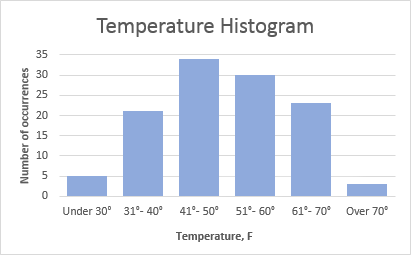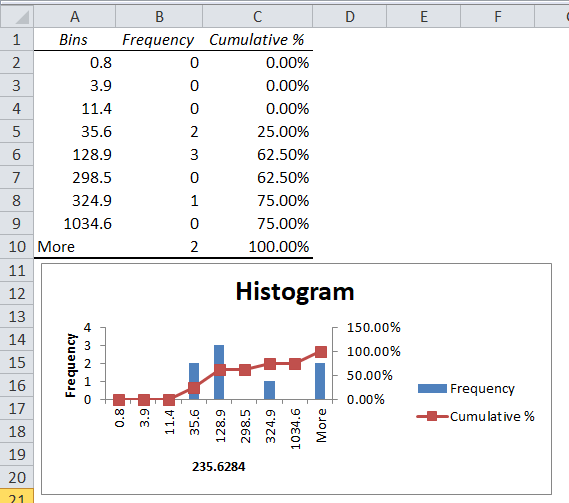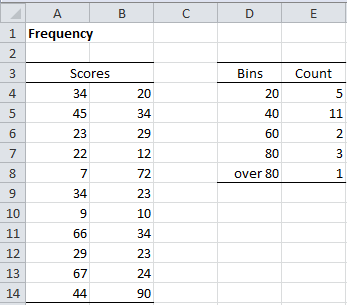
We only do that for a better presentation. So, we change the resultant range’s heading Row Labels to Range and Count of Frequencies to Frequency. Now, we need to calculate the relative frequencies. In the earlier section of this method, we find the frequencies of different number ranges. Step 3: Pivot Table Fields side menu appears.Ĭhecked Quantity in the Pivot Table Fields side menu then Drag the Quantity field to the Rows and Values region as shown in the below screenshot.Īfter executing Step 3, all the frequencies of different number ranges appear in the following image. In PivotTable from table or range dialog box, Mark the New Worksheet option. Step 2: PivotTable from table or range dialog box appears. Step 1: Select the entire dataset after that Go to the Insert Tab > Click on Pivot Table (in the Tables section). To get the frequencies, we use Excel’s Pivot Table feature to count the frequencies then use the frequencies and row labels to insert a Pivot Chart. Method 2: Relative Frequency Distribution Using Pivot Chartįrom the dataset, we know that we don’t have the frequencies for each number range. You can use other forms of charts however for convenience we use the Bar Chart illustration. In the picture, we can see the Relative Frequency Distribution illustrated by a Bar Chart. In the Axis Labels window, Select the Range (i.e., F5:F13) you want to appear in the horizontal axis.Įxecuting all these above-discussed steps leads you to an outcome like the picture below. In the window, Click on Edit (under horizontal axis label).Īll other selections will be made automatically. Step 2: Select the Data Source window that appears. To include the range values in the x-axis you have to edit the chart as instructed in the following steps. You see, in the x-axis, the chart doesn’t include the Bin(range) values. Edit the Bar Chart Title (i.e., Relative Frequency Distribution) as shown in the following image. Then Go to Insert Tab > Select Clustered Column (from the Charts section). Step 1: Select the relative frequency range (i.e., H5:H12). Since we calculate the relative frequency, now we can insert a Bar chart to illustrate the Relative Frequency Distribution. Step 6: Press ENTER then Drag the Fill Handle to bring out all the relative frequencies of each number range. Step 1: Write the following formulas in any adjacent cells (i.e., F5 and G5) to get the Maximum and the Minimum values from the Quantity range. That’s the reason, prior to the frequency or relative frequency calculation we need to find the maximum and minimum values. However, we don’t know the maximum and minimum value of the Quantity amounts.

Then we calculate the relative frequency using the Division Operator ( /). For this reason, we illustrate relative distribution using the Bar and Pivot Chart in the latter sections.Ģ Easy Ways to Illustrate Relative Frequency Distribution in Excel Method 1: Relative Frequency Distribution Using Bar Chart (Calculated by Formula)Īs we have a typical sale dataset with sold Quantity in it, at first, we have to count the occurrences of sold Quantities of the products. We can illustrate this Relative Frequency Distribution using a Bar or Pivot chart. Relative Frequency = ( Frequency within a Range/Total Number of Frequency ) Now, relative frequency is a ratio or quotient of the occurrence time of values within a range and the total occurrence. In an instant, we can figure out that we have 3 instances between 50 to 59 ( range) in our dataset and it goes the same for the others. The above screenshot shows how many values are in those respective ranges in our dataset.

For example, from our dataset, we can count the value instances within a range as shown in the following picture. The number of times an entry occurs in a dataset is frequency. Indeed, the value 3 appears four times in the sample, more than any other numberĪlso, it is useful to construct the cumulative frequencies to see how much is accumulated (in terms of cumulative frequencies) with respect to the total number of frequencies.Calculation and Illustration of Relative Frequency Distribution in Excel.xlsx The mode of that sample is 3, because 3 is the most repeated value. Such relative frequencies can also be graphed and represented with a bar chart ( Often times, it is useful to express the frequencies to normalize them and get what proportion (percentage) of the frequencies are associated to each values. Typically, a frequency table can be represented by a bar chart (a frequency bar chart) to get a clear depiction of the distribution of the variable.


A frequency table corresponds to an organized table that contains the different values that are in the sample along with the frequencies of those values (how many times each value appears in the sample).


 0 kommentar(er)
0 kommentar(er)
